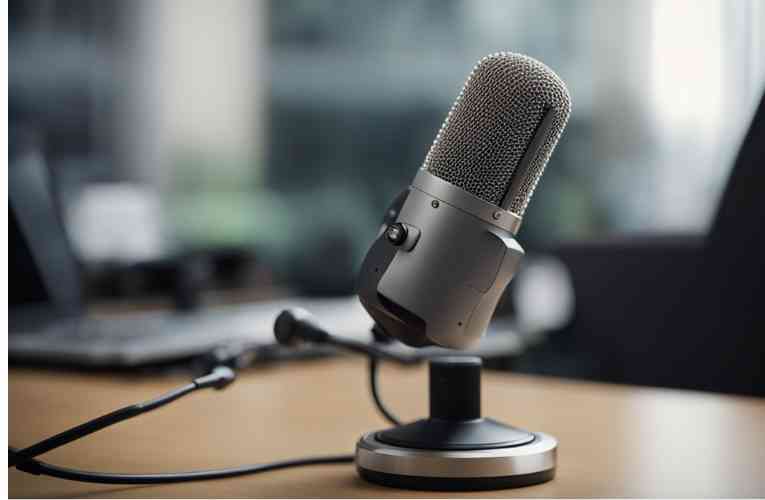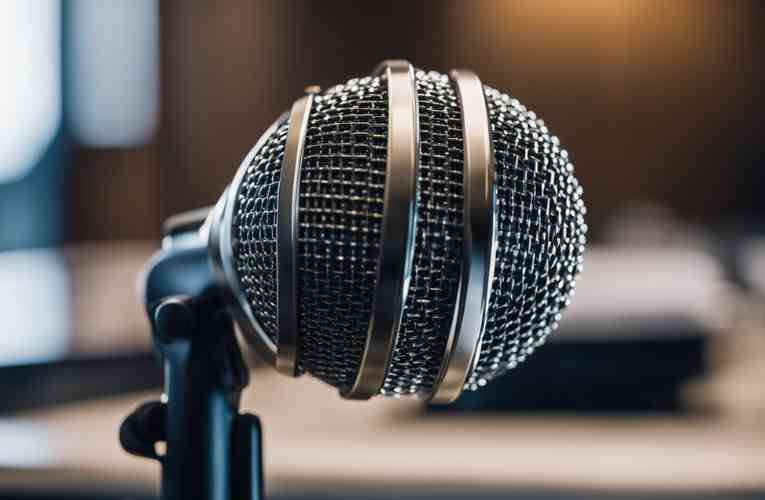Are you tired of recording audio with your condenser microphone only to find out that the sound is too low or almost inaudible? Are you wondering why your condenser mic is so quiet? Don’t worry, you’re not alone. Many people encounter this problem, and it can be frustrating, especially when you’re in the middle of an important recording session.
Understanding condenser microphones is crucial to optimizing recording quality. These microphones are popular among professionals and amateurs alike because of their high sensitivity and excellent transient response. However, technical considerations such as low input gain, bad cable connections, or a lack of phantom power supply can cause your condenser microphone to be too quiet. In this article, we will explore some of the common reasons why your condenser mic is so quiet and provide tips for fixing the issue.
Key Takeaways
- Condenser microphones are sensitive and have excellent transient response
- Technical considerations such as low input gain, bad cable connections, or a lack of phantom power supply can cause your condenser microphone to be too quiet
- Understanding the reasons why your condenser mic is so quiet and how to fix it can help you optimize your recording quality.
Table of Contents
ToggleUnderstanding Condenser Microphones

If you’re experiencing low volume issues with your condenser microphone, it’s important to understand how these microphones work and their different types. This knowledge can help you identify the root cause of the problem.
Types of Condenser Mics
There are two types of condenser microphones: large diaphragm and small diaphragm. Large diaphragm condenser microphones are commonly used for recording vocals and musical instruments, while small diaphragm condenser microphones are used for recording acoustic guitars, drums, and cymbals.
How Condenser Mics Work
Condenser microphones work by converting sound waves into an electrical signal. They have a thin diaphragm that vibrates in response to sound waves, creating an electrical charge. This charge is then amplified by an electronic circuit and output as an audio signal.
One of the main advantages of condenser microphones is their sensitivity to sound. However, this sensitivity can also be a drawback, as it can lead to low volume issues if the microphone is not set up correctly.
To ensure optimal performance, condenser microphones require phantom power, which is typically supplied by an audio interface or mixer. Without phantom power, the microphone will not function properly and may produce low volume output.
Related Posts:
Why is my condenser mic so quiet?

If you are experiencing low or no audio signal when using a condenser microphone, there are a few reasons why this could be happening. In this section, we will explore some common causes of a quiet condenser mic and how to troubleshoot them.
Incorrect Setup
One of the most common reasons for a quiet condenser mic is an incorrect setup. If you are not supplying your mic with the proper amount of phantom power, it will not be able to function correctly. Make sure that you are using the correct type of cable and that your audio interface or mixer is supplying the correct amount of phantom power.
Additionally, make sure that your mic is positioned correctly and that you are speaking directly into it.
Gain Staging Problems
Another potential cause of a quiet condenser mic is gain staging problems. If your input gain is set too low, you will not be able to capture a strong audio signal. On the other hand, if your input gain is set too high, you may experience distortion.
Make sure that your gain levels are set correctly and that you are not clipping your audio signal.
Faulty Equipment
Finally, if you have ruled out incorrect setup and gain staging problems, it is possible that your equipment is faulty. Check your cables and connectors for any damage or wear and tear.
Additionally, make sure that your mic is not damaged in any way. If you suspect that your equipment is faulty, you may need to replace it.
Related Posts:
- Spotting issues with your condenser microphone
- Condenser microphone longevity and fragility
- Clearing up Muffled Audio in a Condenser Mic
Optimizing Recording Quality
When recording with a condenser microphone, it’s important to ensure that your recording quality is optimized to produce the best possible sound. Here are some tips to help you achieve optimal recording quality:
Recording Environment
The environment in which you record can have a significant impact on the quality of your recordings. To optimize your recording environment, consider the following:
- Choose a quiet room: Background noise can be picked up by your microphone and reduce the quality of your recordings. To minimize background noise, choose a quiet room with minimal foot traffic and noise from outside.
- Reduce echo: Echo can be caused by sound waves bouncing off hard surfaces in your recording environment. To reduce echo, consider adding sound-absorbing materials like acoustic foam or blankets to your recording space.
Microphone Technique
The way you use your microphone can also impact the quality of your recordings. Here are some tips to help you use your microphone effectively:
- Position your microphone correctly: The position of your microphone can have a significant impact on the quality of your recordings. To achieve optimal sound quality, position your microphone at a distance of 6-12 inches from your mouth.
- Speak directly into the microphone: Speaking directly into your microphone can help ensure that your voice is picked up clearly and with minimal background noise.
Equipment Upgrades
Upgrading your equipment can also help improve the quality of your recordings. Here are some equipment upgrades to consider:
- Use a pop filter: A pop filter can help reduce popping sounds caused by plosive consonants like “p” and “b” and improve the clarity of your recordings.
- Upgrade your microphone: If you’re still not satisfied with the quality of your recordings, consider upgrading your microphone to a higher-quality model.
By following these tips, you can optimize your recording quality and produce high-quality recordings with your condenser microphone.
Technical Considerations
When troubleshooting a quiet condenser microphone, there are several technical considerations to keep in mind. Two important factors to consider are impedance matching and signal-to-noise ratio.
Impedance Matching
Impedance matching is the process of ensuring that the output impedance of the microphone matches the input impedance of the preamp or audio interface. When the impedance is not matched, the microphone signal can become weak and distorted. It is important to consult the manufacturer’s specifications to ensure that the microphone and preamp are properly matched.
Signal-to-Noise Ratio
Signal-to-noise ratio (SNR) is the ratio of the desired signal to the background noise. A high SNR indicates a strong signal with little noise, while a low SNR indicates a weak signal with a lot of noise. A low SNR can result in a quiet or distorted microphone signal. To improve SNR, it is important to minimize background noise and ensure that the microphone is positioned correctly.
Other technical considerations to keep in mind when troubleshooting a quiet condenser microphone include checking for loose connections, adjusting volume settings, and updating sound card drivers. If the issue persists, consider using a sound booster device or replacing the microphone.
Conclusion
In conclusion, a quiet condenser microphone can be caused by various issues such as low input gain, faulty connections, wrong audio cables, and attenuation pad. Always check your microphone’s volume settings and ensure that it is supplied with phantom power. If the issue persists, consider using a sound booster device or replacing the microphone. Remember to position your microphone correctly and monitor it properly. With these tips, you can troubleshoot and fix your quiet microphone easily.
Frequently Asked Questions
How can I increase the volume of my condenser microphone?
There are several ways to increase the volume of your condenser microphone. First, make sure that your microphone is positioned correctly and close to the sound source. Second, check that the input gain on your audio interface or mixer is set correctly. Third, make sure that your microphone is receiving phantom power if required. Fourth, try using a preamp or amplifier to boost the signal. Finally, you can use software to increase the volume of your microphone, but be careful not to introduce too much noise.
What settings should I adjust to improve my microphone’s volume on Windows 11?
To improve your microphone’s volume on Windows 11, go to the Sound settings and select your microphone. Adjust the input volume slider to increase the volume. You can also try turning on the microphone boost option, but be careful not to introduce too much noise.
Why is my microphone volume low even when set to maximum?
There are several reasons why your microphone volume may be low even when set to maximum. First, check that your microphone is positioned correctly and close to the sound source. Second, check that the input gain on your audio interface or mixer is set correctly. Third, make sure that your microphone is receiving phantom power if required. Fourth, try using a preamp or amplifier to boost the signal.
How do I fix a quiet microphone on Discord?
To fix a quiet microphone on Discord, first, check that your microphone is selected as the input device in the Voice & Video settings. Second, adjust the input volume slider to increase the volume. Third, try turning on the automatic gain control (AGC) option, but be careful not to introduce too much noise.
What steps can I take to boost my mic’s volume on my iPhone?
To boost your mic’s volume on your iPhone, go to the Settings app and select the Control Center. Add the Hearing option to the Control Center and open it. Turn on the Live Listen feature and place your iPhone close to the sound source. This will use your iPhone as a microphone and send the audio to your AirPods or other Bluetooth headphones.
What are the reasons for a headset microphone being too quiet on Xbox?
There are several reasons why a headset microphone may be too quiet on Xbox. First, check that the microphone is positioned correctly and close to the sound source. Second, check that the input gain on your Xbox is set correctly. Third, make sure that your headset is compatible with Xbox. Fourth, try using a preamp or amplifier to boost the signal. Finally, you can try adjusting the microphone settings in the Xbox settings menu.








